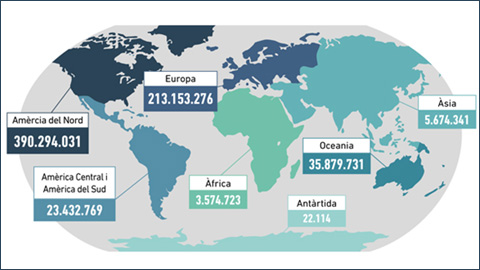Citizen science, a great ally for biodiversity

20/12/2016
The study, published in the journal Biological Conservation, included the participation of Bernat Claramunt, lecturer of the Department of Animal and Plant Biology and Ecology and researcher at CREAF, for whom “citizen science currently provides a large amount of data on biodiversity which is useful to science, but this information still has more potential to assess biodiversity at regional and global scales”. In fact, 50% of the data included in the Global Biodiversity Information Facility (GBIF) is provided by citizen science.
Biodiversity is essential for humans and for the planet, and "there is a need to preserve it against the continuous threats made by human actions, because it provides us with multiple environmental services such as pollination, plague control and protection against perturbations", Claramunt explains. To learn about the state of biodiversity, one must carefully monitor the indicators showing its state in each point of the planet, such as phenology, migratory behaviour, bioindicator species, population age structures, and the distribution of species.
However, this information is not always available and to solve this, the study identifies what type of data is commonly provided by citizen science and what types are missing. “Many data covers the distribution of species - whether it is present or absent from a place. But there are other biodiversity variables which are not monitored by citizen science, and can only be obtained through observations and measures conducted by scientists, such as demography, and characteristics such as the body weight of organisms”, Bernat Claramunt explains. For this reason, citizen science cannot be seen as a substitute for the work done by the scientific community. It is rather a highly valuable complement which allows learning more about some of the aspects relevant to the conservation of biodiversity.
Birds, Butterflies and Mushrooms are the Favourites
The study also detects that the groups benefiting most from citizen science are by far birds, followed by mushrooms and butterflies. Even so, “we have seen that this large representation of certain groups is globally not homogeneous, and neither is the degree to which citizen science exists around the world”, the researcher affirms. For example, citizen science provides more data in some European countries, the US and Australia. This does not happen however in other countries which are highly interesting for their biodiversity, and where citizen science projects are still few.
For this reason, Claramunt adds that it is important to foster citizen science, given that “the more data and people implied, the easier it will be to have information on rare species”. And that would be especially useful in the detection of invading species, up to the point in which citizen science projects could become a preliminary alert system when facing invasions.
Citizen Science in Catalonia and Spain
In Catalonia, birds are the best represented thanks to initiatives such as the programme of the Common Bird Monitoring in Catalonia (SOCC) of the Catalan Institute of Ornithology (ICO), and the SEO/BirdLife organisation in Spain. This shows the potential of citizen science and how it can expand to areas it still does not exist. “There is a positive trend here, there's been a huge boom”, Claramunt firmly states. He adds that “the Spain GBIF is working hard on the Natusfera project, and several workshops on citizen science have been organised in different regions of Spain”.
Harmonising Citizen Science Projects and Information
Nevertheless, Bernat Claramunt highlights that “there is a problem with the available resources, a lack of technical elements and the need to create new databases”. In fact, according to the CREAF and UAB researcher, one of the priorities worldwide is to allow different citizen science platforms and projects to communicate and share a common language. “We aim to harmonise the projects and standardise the type of data we collect, so that all projects follow the same norms and structures, are easier to classify and one can find what is searched for.”
CREAF acknowledges the potential of citizen science and is preparing projects largely based on this resource, such as the MosquitoAlert, Fenodato and Natusfera, of which Claramunt is the lead researcher.
Original article: Chandler, M., Claramunt López, B., et al. (2016). “Contribution of citizen science towards International biodiversity monitoring”, Biological Conservation. http://dx.doi.org/10.1016/j.biocon.2016.09.004
Images (CREAF):
http://www.uab.cat/uabdivulga/img/UAB-CREAF-EstudiCienciaCiutadana1.jpg
Percentage of GBIF data provided by citizen science. A total of 70% of data on animal diversity is uploaded by citizens, especially due to the importance given to birds and butterflies. People also offer large amount of information on mushrooms, but not as much on other plants.
http://www.uab.cat/uabdivulga/img/UAB-CREAF-EstudiCienciaCiutadana2.jpg
Number of observations on biodiversity gathered in each continent. North America, Europe and Australia are regions of the world in which citizen science is more widespread. It is precisely in these areas in which birds and butterflies are best represented.